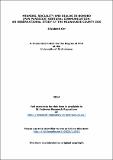Meaning, sociality and dialog in bonobo (Pan paniscus) gestural communication : an observational study at the Milwaukee County Zoo
Abstract
Apes use gestures in an intentional and highly flexible manner. It has been proposed that human language originated in gestural communication and therefore ape gestures have been of great interest to primatologists and psychologists alike. The extensive, flexible and intentional nature of ape gestural communication may also provide new insights to the study of social regulation as large communicative systems are thought to be useful in navigating complex social landscapes. To date studies of bonobos and their use of gestures has occurred in limited contexts and therefore the known repertoire of bonobos is relatively small. It is also unknown as to what bonobos use gestures for and whether they use those gestures flexibly in order to regulate their social relationships. To investigate these questions I studied a captive population of bonobos for 12 months at the Milwaukee County Zoo, Wisconsin, USA. Milwaukee bonobos used 55 gesture types over the course of the study period. I found that bonobos have particular goals behind their signalling and that bonobos used gestures consistently for specific goals and that the same gestures were used for the same goals across signallers. It was therefore possible to identify to meanings behind over half of the gestures within the bonobo repertoire. Even though the meanings of gestures were consistent across signallers, the age and sex of a signaller influenced what context and for what purpose he or she used gestural communication. Particular types of signallers used gestures for particular goals and directed those gestures towards particular recipients. Bonobos also used gestures within dialog during special circumstances in order to coordinate asymmetrical interactions. These results indicate that gestural communication is an excellent medium for investigating the influence a large, intentional and flexible communication system has on managing a complex social network.
Type
Thesis, PhD Doctor of Philosophy
Collections
Items in the St Andrews Research Repository are protected by copyright, with all rights reserved, unless otherwise indicated.

